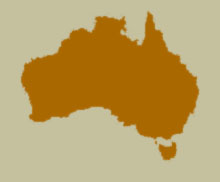Synonyms
Orcus quadrimaculatus Gadeau de Kerville, 1884: 72.
Diagnosis
The presence of two maculae on each elytron immediately distinguishes this species from the other Australian Orcus.
Description
Length 4.7-5.3 mm. Dorsal surface predominantly metallic dark bluish; each elytron with 2 orange maculae as in Figure 46; antennae, labial palp, and last four abdominal ventrites yellowish; rest dark brown. Body elongate, somewhat flattened. Head micro reticulate between punctures; punctation smaller than eye facets, very shallow, almost indistinct, nearly 2 diameters apart. Eyes with inner margin slightly diverging apically. Antennae 8-segmented; pedicel about as long as greatest width; 3rd antennomere longer than pedicel; 8th elongate, 2 times longer than basal width. Terminal maxillary palpomere very narrow; sides nearly parallel; apex oblique with outer side about 2 times longer than inner; terminal labial palpomere slightly elongate, about 2 times longer than basal width, visibly shorter then preceding segment. Pronotal surface sculptured as on head; punctation about as large as eye facets; as shallow as on head, approximately 1.5 to 2 diameters apart; the punctures obsolete on anterior angles; anterior angles without distinct strigae; lateral borders rounded; bordering line uninterrupted at base, the line slightly opening anteriorly, ending in a weak depression before lateral border; prosternum short in front of coxae about 1.5 times longer than prosternal process widest width; hypomeral foveae absent; hind tibiae with outer tooth; tarsal claws weakly appendiculate. Elytral surface polished between punctures; punctation as on pronotum, slightly deeper; lateral margin slightly reflexed, without clear bead; epipleural foveae absent. Abdomen 6 ventrites; 6th short, straight to slightly emarginate at apex; surface of ventrite 1 somewhat microstriate between postcoxal lines; postcoxal lines joined at middle, running parallel to posterior margin of ventrite, almost reaching lateral margin; apical border of intercoxal process flat.
Male
Tegmen relatively long, about as long as abdomen length; penis guide symmetrical, distinctly longer than parameres; parameres densely setose at apex, the setae short; strut about 1/2 the tegmen length; penis as figured.
Female
Female externally identical to male, except having only 5 visible abdominal ventrites; 5th ventrite rounded, somewhat oval.
Variation
Unknown.
 Distribution and Biology
Distribution and Biology
Recorded from few localities in New South Wales.
Species References
Gadeau de Kerville, H. 1884. Descriptions de quelques espèces nouvelles de la famille des Coccinellidae . Annales de la Société Entomologique de France, 6e Séries, 4: 69-72, pl. 4.
Slipinski, S.A. 2007. Australian Ladybird Beetles (Coleoptera: Coccinellidae) their biology and classification. ABRS, Canberra. 286 pp.
Slipinski, A. and Giorgi, J.A. 2006. Revision of the Australian Coccinellidae (Coccinellidae). Part 6. Tribe Chilocorini. Annales Zoologici (Warszawa), 56(2): 265-304.
[ Top ]
